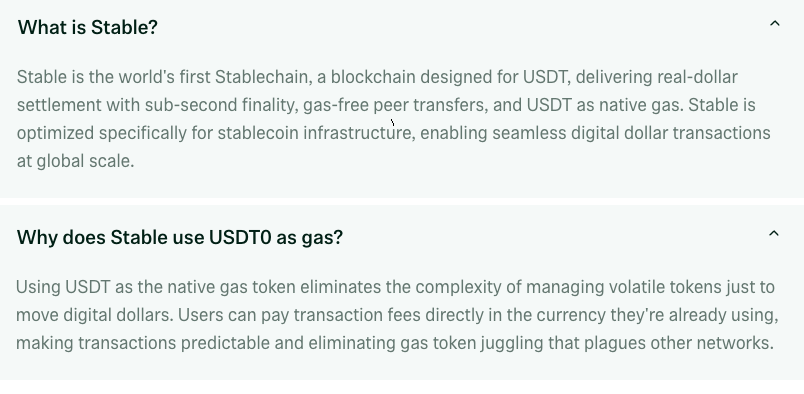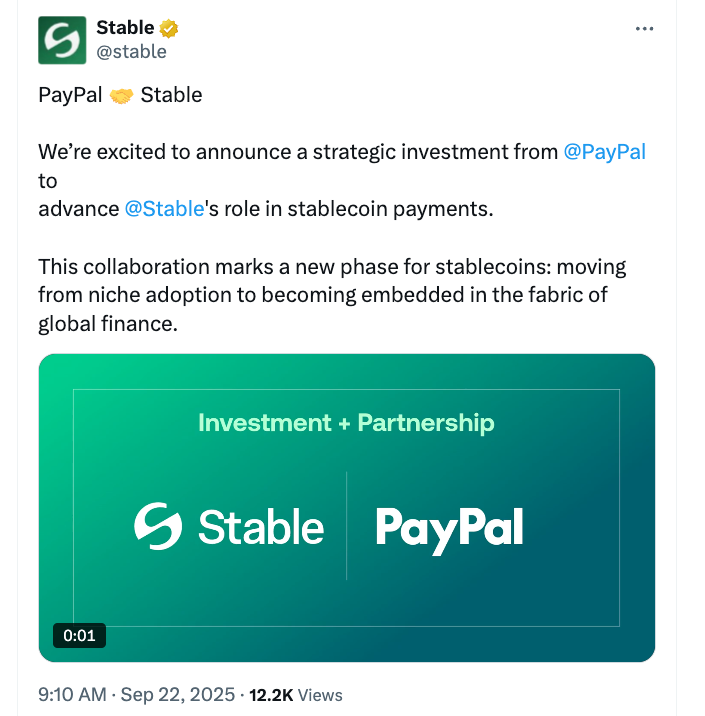Stable, a Bitfinex-backed layer‑1 blockchain, has secured PayPal Ventures’ investment to integrate PayPal USD (PYUSD) onto the Stablechain. The move aims to expand PYUSD commerce use cases while leveraging Stable’s low‑latency, USDT‑native design for fast, gas‑free dollar transfers.
-
PayPal Ventures invests to bring PYUSD to Stablechain
-
Stable is a Bitfinex‑backed layer‑1 focused on instant, dollar‑settled transfers and native USDT support.
-
PYUSD adoption could target commerce and remittances; PYUSD market cap ~ $1.4B vs USDT $172B (source: CoinGecko).
PayPal USD PYUSD joins Stablechain: Stable and PayPal Ventures collaborate to expand PYUSD use cases on a USDT‑designed layer‑1. Read how this affects stablecoin payments.
Stable, a Bitfinex-backed blockchain linked to Tether, announced PayPal Ventures’ support to bring the PayPal USD stablecoin onto its network.
Stable, an institutional‑grade stablecoin blockchain backed by Bitfinex, confirmed that PayPal Ventures has made a strategic investment to help integrate PayPal USD (PYUSD) onto the Stablechain.
What is Stable and how will PayPal integrate PYUSD?
Stable is a layer‑1 blockchain built for dollar payments with USDT as a native gas design offering sub‑second finality and gas‑free peer transfers. PayPal Ventures’ investment will support PYUSD deployment on the Stablechain to enable new commerce and remittance workflows.
How does Stable’s USDT‑native design work?
Stable’s architecture prioritizes real‑dollar settlement by using USDT as the native gas token, which removes the need for volatile cryptocurrencies just to move dollars. The network advertises sub‑second finality and gas‑free peer transfers to reduce friction for commerce, remittances and cross‑border payments.

Stable FAQ. Source: Stable
Why is PayPal Ventures investing in Stable?
PayPal Ventures says the investment is aimed at expanding PYUSD’s utility across multiple chains, unlocking commerce‑focused use cases where fast, fiat‑like settlement matters. PayPal ecosystem head David Weber emphasized adoption across blockchain ecosystems as a priority.
What are the current market positions of PYUSD and USDT?
PYUSD, launched in collaboration with Paxos (August 2023), sits well below Tether’s USDT in market cap. PYUSD is around $1.4 billion in market cap while USDT remains the largest stablecoin at roughly $172 billion (source: CoinGecko).
How might commerce and remittance use cases change?
Integrating PYUSD on Stablechain could enable merchants and payment providers to settle dollar payments quickly without converting through volatile gas tokens. This supports instant payouts, low‑cost cross‑border transfers, and programmable commerce flows.

Source: Stable
Is Stable connected to other dollar stablecoins?
Stable is closely tied to USDT and also references USDT0 (a cross‑chain liquidity stablecoin introduced by Everdawn Labs) in project documentation. It is not definitively clear which token functions as the canonical native gas token in all deployments; Stable has public FAQs that address token behavior.
Comparison: PYUSD vs USDT (market snapshot)
| Metric | PYUSD | USDT |
|---|---|---|
| Approx. market cap | $1.4B (CoinGecko) | $172B (public market data) |
| Primary issuer | PayPal / Paxos (launch partner) | Tether |
| Target use cases | Commerce, payouts, on‑ramp | Liquidity, cross‑chain payments |
Frequently Asked Questions
Will PYUSD replace USDT on Stablechain?
PYUSD is being added as a supported stablecoin for commerce use cases, but Stable’s design still emphasizes USDT as a native gas token. The integration expands options rather than replacing USDT.
When did Stable emerge and who funds it?
Stable emerged from stealth in July 2025 with a $28 million seed round co‑led by Bitfinex and Hack VC and additional backers. PayPal Ventures’ recent investment supports PYUSD integration.
Key Takeaways
- Strategic investment: PayPal Ventures backed Stable to bring PYUSD to the Stablechain.
- Architecture: Stable focuses on USDT‑native gas, sub‑second finality and gas‑free transfers.
- Use cases: Integration targets commerce, remittances and instant dollar settlement.
Conclusion
The PayPal Ventures investment signals a growing focus on integrating payment‑oriented stablecoins like PYUSD into networks optimized for fiat settlement. Stable’s USDT‑centric architecture and Bitfinex backing could accelerate real‑world payments use cases; stakeholders should watch integration milestones and regulatory disclosures.
